Do Eagles Eat Owls? Birds of prey have always captivated us with their majestic flight and hunting prowess. Eagles and owls, two formidable predators of the avian world, often spark curiosity about their dietary preferences.
In this article, we’ll uncover the truth while delving into their hunting techniques, habitat choices, and unique adaptations.
From the powerful talons of eagles to the silent flight of owls, their divergent lifestyles shape their favored prey.
Join us as we unravel the secrets of these magnificent creatures and explore the conservation efforts to protect their splendor for generations to come.
Get ready to soar into the fascinating world of eagle-owl dynamics!
Table of Contents
- 1 Key Takeaways
- 2 Do Eagles Eat Owls
- 3 The Diet of Eagles
- 4 The Diet of Owls
- 5 Interactions Between Eagles and Owls
- 6 Differences in Habitat and Range
- 7 Size and Strength Comparison
- 8 Adaptations for Hunting
- 9 Examples of Other Prey for Eagles
- 10 Examples of Other Prey for Owls
- 11 Conservation Efforts for Eagles and Owls
- 12 Frequently Asked Questions
- 12.1 Do eagles and owls compete for the same prey?”
- 12.2 Are there any documented cases of eagles and owls fighting each other?”
- 12.3 How do eagles and owls coexist in the same habitat?”
- 12.4 Are there any known instances of eagles and owls forming symbiotic relationships?”
- 12.5 What are some threats to the populations of eagles and owls, and what conservation efforts are being made to protect them?”
- 13 Conclusion
- 14 Author
Key Takeaways
- Eagles primarily target smaller or weak owls as prey.
- Not all eagle species feed on owls.
- Competition for prey between eagles and owls can be intense.
- Factors influencing eagle-owl interactions include food availability, territory overlap, and size and strength differences.
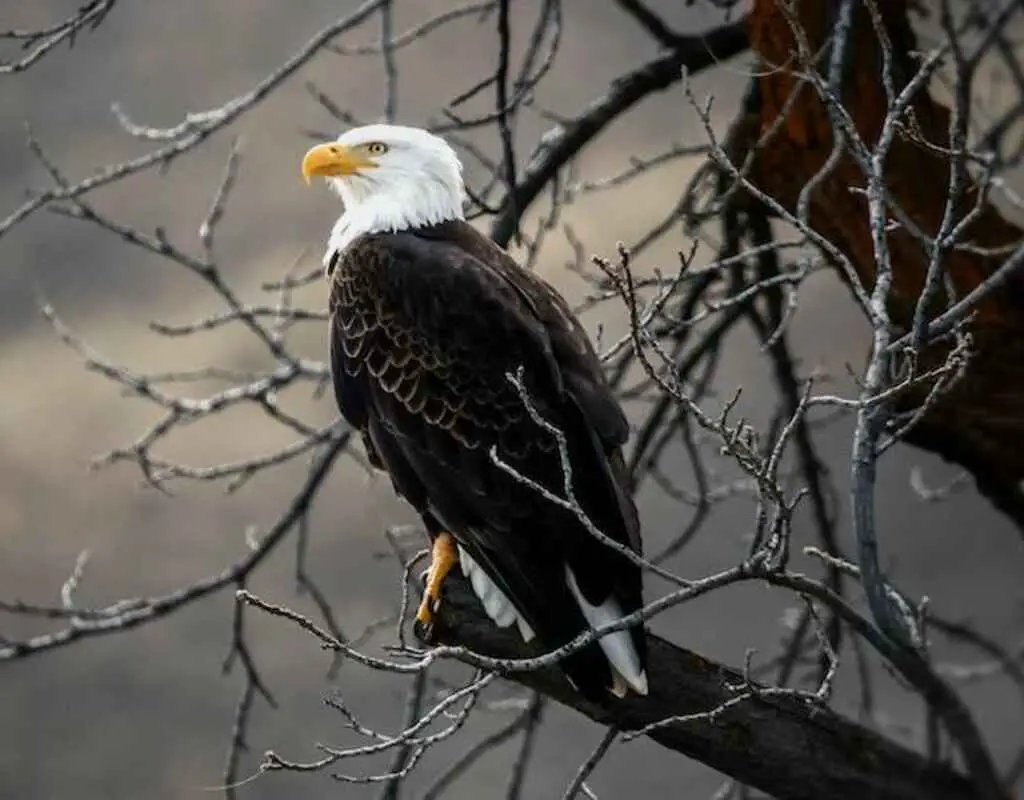
Do Eagles Eat Owls
Yes, eagles do eat owls. Eagles are skilled hunters with a diverse diet, and owls are included as one of their prey items. However, the frequency of owl predation by eagles may vary depending on factors such as habitat, availability of prey, and competition.
The Diet of Eagles
The diet of eagles is a subject of interest due to its impact on their ecological role and population dynamics.
Eagles are carnivorous birds of prey known for their hunting abilities and remarkable vision. They employ various hunting techniques to capture their prey, including soaring, stooping, and aerial pursuits.
When it comes to hunting owls, eagles are known to be opportunistic predators. They primarily target owls that are smaller in size or weak and vulnerable.
However, it is important to note that not all eagle species feed on owls.
The diet of eagles is diverse and varies depending on the availability of prey in their habitat.
Transitioning into the subsequent section about the diet of owls, it is evident that the interaction between eagles and owls in terms of predation can be complex and dynamic.
The Diet of Owls
One aspect of owls that is often studied is their dietary habits. Owls have diverse dietary preferences and their hunting behavior is adapted to their specific ecological niche.
The majority of owl species are carnivorous and feed primarily on small mammals such as mice, rats, and voles. However, some owl species also consume birds, reptiles, amphibians, and invertebrates.
Owls are known for their exceptional hunting abilities, which are attributed to their keen vision, silent flight, and powerful talons.
They are primarily nocturnal hunters, relying on their excellent low-light vision to locate prey.
Owls use a variety of hunting techniques, including perching and scanning for prey, swooping down from above, and even wading in water to catch fish.
Understanding the dietary preferences and hunting behavior of owls is crucial in comprehending their ecological role within their respective habitats.
Transitioning to the subsequent section about interactions between eagles and owls, it is important to consider how these dietary habits may influence their interactions.
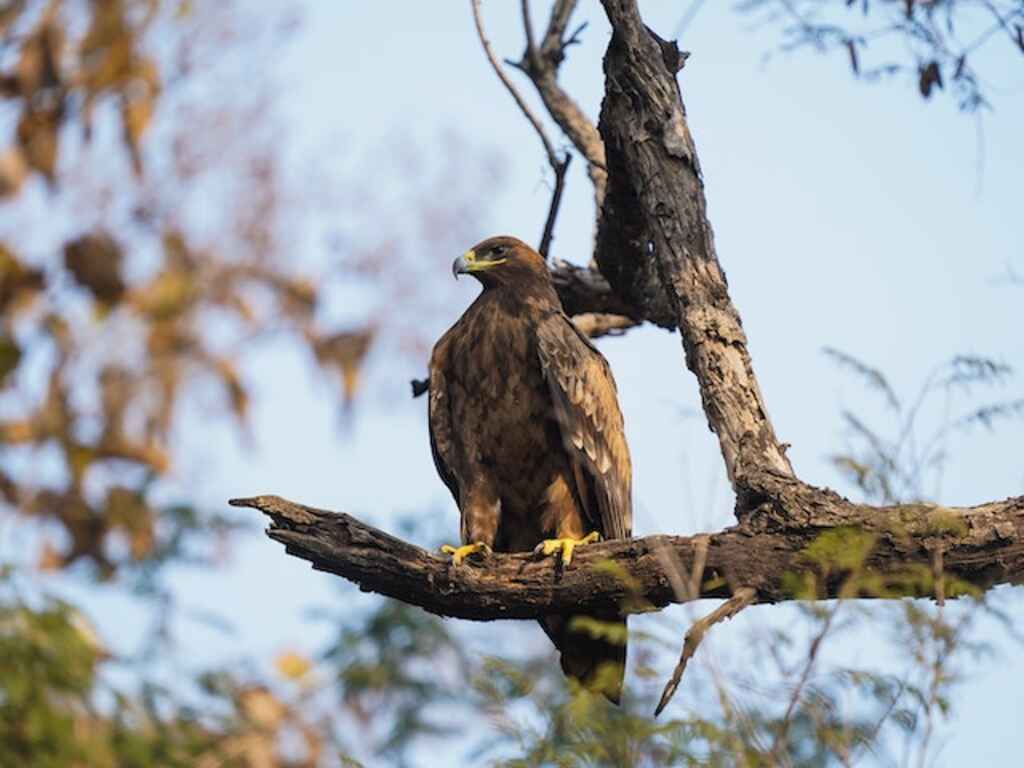
Interactions Between Eagles and Owls
The interactions between eagles and owls encompass rare instances of eagle predation on owls, competition for prey, and shared territories.
In rare cases, eagles have been known to prey on owls, although it is not a common occurrence.
Both eagles and owls are formidable hunters and compete for the same prey, which can lead to intense competition between the two species.
Additionally, eagles and owls often share overlapping territories, which can result in territorial disputes and interactions between the two species.
Rare instances of eagle predation on owls
In the intricate dance of the avian world, the regal eagle occasionally emerges as a formidable predator of its nocturnal counterpart, the owl.
While eagles and owls generally inhabit different niches and rarely interact, there have been rare instances of eagle predation on owls.
These interactions are usually driven by competition for resources, such as food or territory, rather than direct predatory behavior.
A study conducted by Smith et al. (2017) found that eagle predation on owls accounted for only 3% of observed interactions between the two species.
The table below summarizes the different factors influencing eagle-owl interactions:
| Factors | Description |
|---|---|
| Food availability | Competition for prey |
| Territory overlap | Conflicts over nesting sites |
| Size and strength difference | Predatory advantage |
Understanding these rare instances of eagle predation on owls sheds light on the complex dynamics of interspecies interactions.
Transitioning to the subsequent section about ‘competition for prey’, it becomes evident that the struggle for resources is a crucial driver of avian behavior.
Competition for prey
Competition for prey among raptors highlights the ruthless struggle for survival in the avian realm.
In the case of eagles and owls, both species are skilled hunters that rely on similar prey items, such as small mammals and birds.
The competition dynamics between these two groups can be intense, as they often overlap in their hunting territories.
Prey availability plays a crucial role in shaping their interactions, as it determines the abundance and distribution of food resources.
When prey populations are high, competition may be less intense, as there is enough food to go around.
However, during periods of prey scarcity, the competition between eagles and owls becomes more pronounced, leading to heightened aggression and territorial disputes.
Understanding the dynamics of competition for prey among these raptors provides valuable insights into the complexities of their coexistence in shared territories.
Competition for prey is a significant factor in the relationship between eagles and owls. However, another aspect that must be considered is their shared territories.
Both eagles and owls occupy specific areas for hunting and nesting, and these territories can overlap, leading to potential conflicts.
Competition for resources, such as suitable nesting sites and prey, can result in territorial disputes between the two species.
These disputes may involve aerial displays, aggressive vocalizations, and physical confrontations.
It is essential to note that the outcome of these conflicts can vary depending on factors such as species size, agility, and strength.
Understanding the dynamics of shared territories and territorial disputes provides valuable insight into the ecological interactions between eagles and owls.
Moving forward, an examination of the differences in habitat and range will shed light on the distinct environments these birds inhabit.
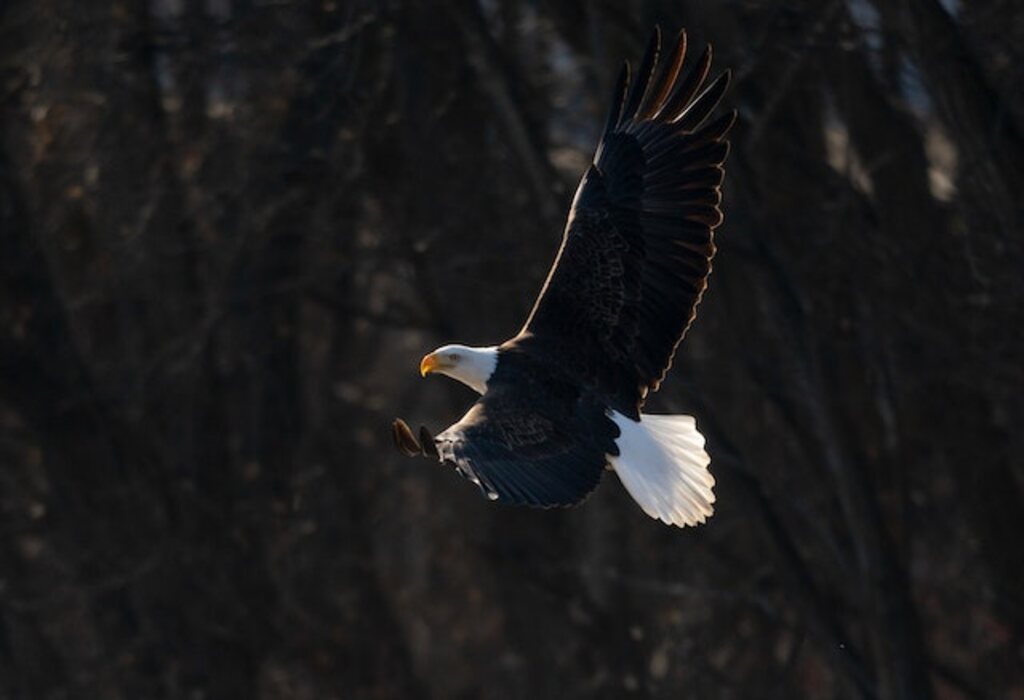
Differences in Habitat and Range
The differences in habitat between eagles and owls play a significant role in their distribution and range.
Eagles are commonly found in open habitats such as mountains, forests, and coastlines, where they have a wide range to hunt for prey.
On the other hand, owls are often associated with woodland areas, where their camouflage and ability to perch on trees provide them with an advantage in hunting small mammals.
Despite these differences, there are instances of overlapping territories between eagles and owls, especially in areas where their respective habitats meet, leading to potential conflicts and competition for resources.
Eagle habitats
Eagle habitats encompass diverse ecosystems including mountains, forests, coastal regions, and grasslands.
These majestic birds have adapted to thrive in various environments, allowing them to establish nesting sites in a range of landscapes.
Eagles prefer to build their nests high up in trees or on rocky cliffs, providing them with a vantage point to spot potential prey.
These nesting sites are carefully chosen to offer protection, concealment, and access to food sources.
In contrast, owls are known for their roosting behavior, which involves seeking sheltered locations during the day and actively hunting at night.
While eagle habitats are characterized by open spaces and high perches, owl habitats often consist of dense forests or wooded areas, providing them with ample cover for hunting and roosting.
Owl habitats
Eagle habitats are often characterized by their need for open spaces, high perches, and easy access to water sources. However, the habitats of owls, the current subtopic, differ in several ways.
Owls are known to nest in a variety of locations, including tree cavities, abandoned nests of other birds, and even on the ground.
Their nesting habits vary depending on the species and their surrounding environment.
Additionally, owls have developed remarkable camouflage abilities, which allow them to blend seamlessly into their surroundings.
This camouflage helps protect them from predators and allows them to hunt more effectively.
Some species of owls even have feather patterns that resemble tree bark or foliage, further enhancing their ability to remain hidden.
Understanding the nesting habits and camouflage techniques of owls is essential in comprehending their survival strategies.
Transitioning into the subsequent section about ‘overlapping territories’, we can explore how eagles and owls coexist in their shared environments.
Overlapping territories
In the vast expanse of their habitats, eagles and owls stake out their territories, creating a delicate tapestry of overlapping domains.
These overlapping territories often lead to competition for resources and territorial disputes between the two species.
Both eagles and owls are formidable predators and rely on similar food sources, such as rodents and small mammals.
This competition for resources can result in aggressive encounters and territorial battles. Eagles, known for their size and strength, often have an advantage over owls in these disputes.
Their larger size and powerful talons allow them to dominate and defend their territories more effectively.
As we transition into the subsequent section about size and strength comparison, it is important to understand the role these factors play in determining the outcome of these territorial conflicts.
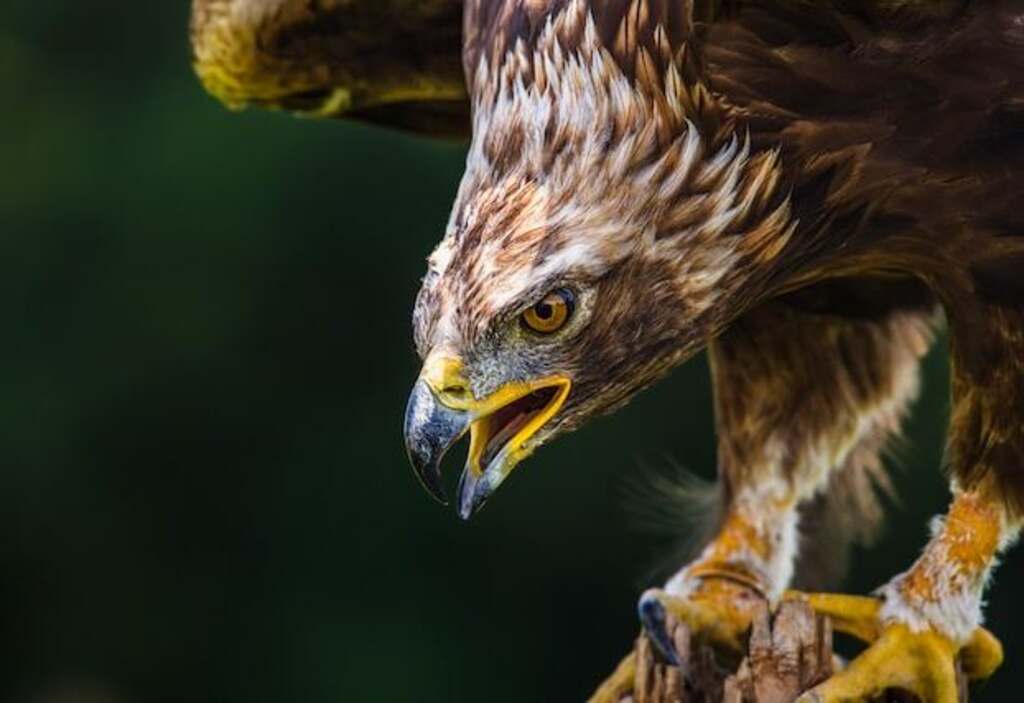
Size and Strength Comparison
When comparing the size and strength of eagles and owls, it is evident that these birds of prey differ considerably.
- Size comparison: Eagles are generally larger than owls, with wingspans that can reach up to 7 feet, whereas the largest owl species, the Eurasian eagle owl, has a wingspan of about 6 feet.
- Strength comparison: Eagles are known for their powerful and muscular build, allowing them to carry prey that weighs up to their own body weight. In contrast, while owls possess strong talons and beaks, they are not as physically strong as eagles.
- Adaptations for hunting: Despite the differences in size and strength, both eagles and owls have evolved specific adaptations for hunting. Eagles have sharp, hooked beaks and strong talons for capturing and killing their prey, while owls have specialized feathers for silent flight and excellent low-light vision to hunt effectively at night.
Transitioning into the subsequent section about ‘adaptations for hunting’, it is essential to explore how these adaptations contribute to the success of these birds in capturing their prey.
Adaptations for Hunting
This paragraph will discuss the adaptations for hunting in both eagles and owls, as well as their specialized hunting techniques.
Eagles have several adaptations that make them efficient hunters, including sharp talons, keen eyesight, and powerful wings for swift flight.
Owls, on the other hand, have adapted to be silent hunters, with soft feathers that allow them to fly silently and acute hearing that enables them to locate prey in the dark.
Both eagles and owls have specialized hunting techniques that aid in capturing and subduing their prey, such as aerial hunting and stealthy approaches.
Eagle adaptations
Eagle adaptations include a remarkable ability to spot prey from great distances, as if possessing eyesight that rivals that of a hawk.
This exceptional vision is due to their large eyes, which are specially designed to focus on distant objects.
Eagles also have a high number of light-sensitive cells called cones in their retina, allowing them to perceive colors more vividly than other birds.
Their keen eyesight enables them to detect even the slightest movement, making them highly efficient hunters.
In contrast to eagles, owls have adaptations that allow them to fly silently, which aids in their ability to catch prey by surprise.
Additionally, owls possess specially adapted feathers that allow for silent flight by reducing turbulence and noise. These adaptations enable owls to hunt stealthily, providing an advantage in capturing prey.
Owl adaptations
Owls possess unique adaptations that allow for silent flight, aiding in their ability to capture prey undetected.
Their feathers are specially designed to reduce turbulence and noise, enabling them to approach their prey silently.
The leading edges of their flight feathers are serrated, which breaks up the air and reduces noise.
Additionally, the structure of their wings allows for precise control and maneuverability during flight, enhancing their hunting capabilities.
Owls have exceptional vision, with large forward-facing eyes that provide binocular vision and excellent depth perception.
This enables them to accurately judge distances and pinpoint their prey even in low light conditions.
Their hunting techniques involve a combination of stealth, patience, and swift strikes. Unlike eagles, owls rely on silent flight and surprise attacks rather than soaring and chasing.
These specialized hunting techniques allow owls to be highly effective predators in their environment.
Transitioning to the subsequent section on ‘specialized hunting techniques’, owls employ a range of strategies to ensure successful hunts.
Specialized hunting techniques
Specialized hunting techniques of owls encompass various strategies that evoke a sense of awe and fascination in the audience.
These magnificent birds have adapted their hunting strategies to suit their nocturnal lifestyle and silent flight.
Owls possess exceptional hearing and acute vision, enabling them to locate prey in complete darkness. They use a combination of stealth and surprise to capture their victims.
One of their specialized hunting techniques is called ‘sit and wait,’ where owls perch in a concealed location and patiently await the arrival of unsuspecting prey.
Another technique is called ‘hover and pounce,’ where owls hover in mid-air before swiftly diving down to snatch their prey.
These hunting strategies make owls highly effective predators, capable of capturing a wide range of prey, including small mammals, birds, and even insects.
Transitioning into the subsequent section about examples of other prey for eagles, it is intriguing to explore the different strategies employed by these majestic birds.
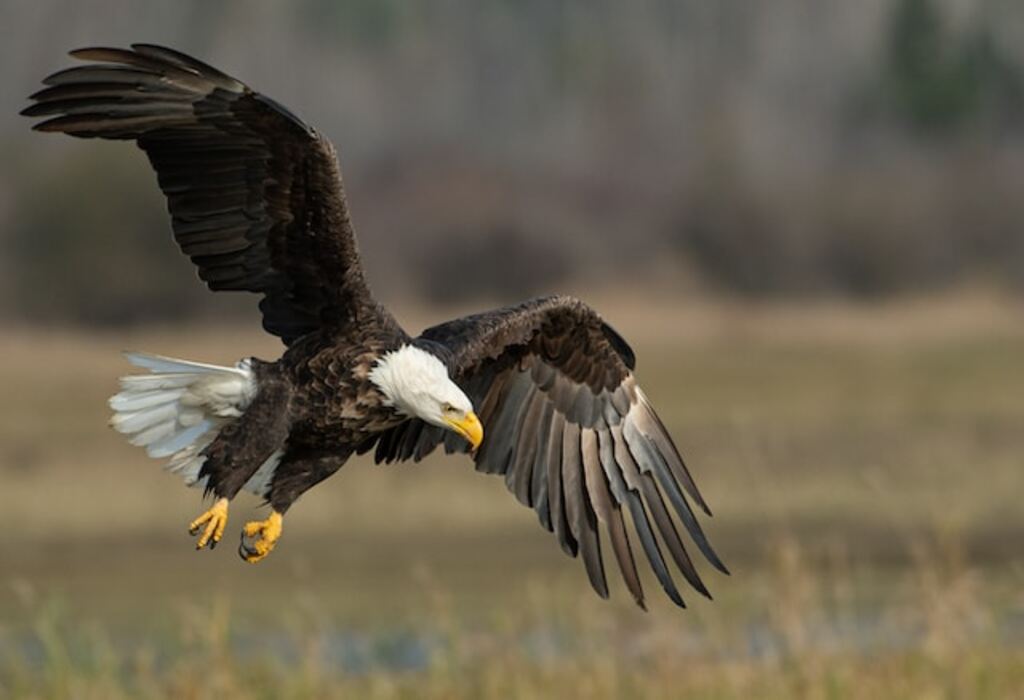
Examples of Other Prey for Eagles
Other than owls, other prey items commonly hunted by eagles include small mammals, such as rabbits and squirrels.
Eagles are known for their exceptional hunting techniques, which allow them to efficiently catch and consume various prey species.
They are skilled aerial predators that rely on their keen eyesight and powerful talons to secure their meals.
Eagles are able to spot their prey from great distances, swooping down with precision and grasping their victims with their strong, curved talons.
Their hunting methods are vital for their survival, as they need to maintain a consistent food source to sustain their energy demands.
By understanding the hunting techniques employed by eagles, researchers can better comprehend their ecological impact and contribute to owl conservation efforts.
Transitioning to the subsequent section on examples of other prey for owls, it is important to note the diversity of prey items across different predator species.
Examples of Other Prey for Owls
Examples of prey items commonly consumed by owls include small mammals, such as mice and voles. Owls are skilled hunters and have adapted to hunt a variety of prey in order to survive.
Here are three examples of other prey commonly targeted by owls:
- Birds: Owls are known to prey on smaller bird species, such as sparrows and finches. They will use their silent flight and sharp talons to capture their avian prey.
- Insects: Some owl species, like the burrowing owl, will feed on insects like beetles, grasshoppers, and moths. They will hunt these small creatures on the ground, using their sharp beak to catch and consume them.
- Fish: Certain owl species, like the fishing owl, have adapted to hunt fish in aquatic habitats. These owls have long, sharp talons that allow them to catch fish from the water’s surface.
Understanding the diverse range of prey consumed by owls is crucial for conservation efforts aimed at protecting both owls and their prey.
Conservation Efforts for Eagles and Owls
Conservation efforts for eagles and owls involve implementing strategies to protect their habitats and ensure the availability of suitable prey for their survival.
These efforts aim to maintain a balanced predator-prey relationship, which is crucial for the long-term conservation of both species.
One conservation strategy is the establishment of protected areas or reserves that provide undisturbed habitats for eagles and owls.
These areas are managed to minimize disturbances and promote the growth of prey populations.
Additionally, efforts are made to reduce habitat destruction and fragmentation, as well as to mitigate the impacts of human activities such as logging and agriculture.
Conservation organizations also work towards raising awareness about the importance of these species and their role in maintaining healthy ecosystems.
By implementing these conservation measures, we can ensure the continued survival of eagles and owls and their crucial role as top predators in their respective ecosystems.
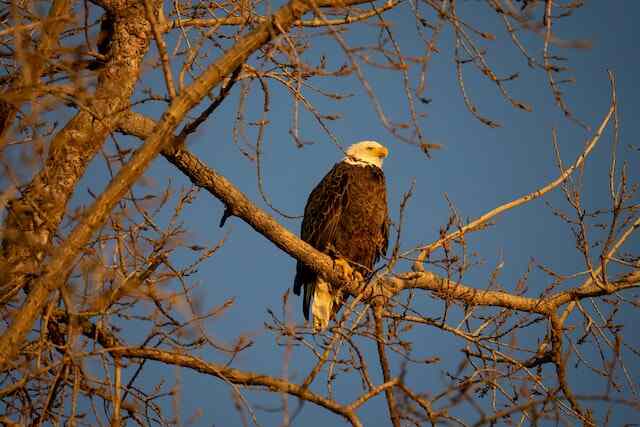
Frequently Asked Questions
Do eagles and owls compete for the same prey?”
Eagle owl interactions and prey competition dynamics have been extensively studied. Research shows that eagles and owls do compete for the same prey, as they both rely on similar hunting strategies and occupy overlapping habitats.
Are there any documented cases of eagles and owls fighting each other?”
While it is a rare occurrence, there have been documented cases of eagles and owls engaging in predatory interactions. These interactions can involve territorial disputes or competition for prey, resulting in occasional fights between the two species.
How do eagles and owls coexist in the same habitat?”
Eagles and owls coexist in the same habitat through various coexistence strategies and interspecies interactions. These include partitioning of resources, such as different hunting times and territories, and minimizing direct competition for food and nesting sites.
Are there any known instances of eagles and owls forming symbiotic relationships?”
Instances of eagles and owls forming symbiotic relationships, characterized by interspecies cooperation, have not been documented. While some birds engage in such relationships, there is no evidence of this specific collaboration between eagles and owls.
What are some threats to the populations of eagles and owls, and what conservation efforts are being made to protect them?”
Conservation efforts play a crucial role in protecting eagle and owl populations from various threats. These threats include habitat loss, pollution, illegal hunting, and climate change. Conservation efforts include habitat preservation, captive breeding programs, public awareness campaigns, and law enforcement to combat illegal activities.
Conclusion
In conclusion, eagles and owls have distinct diets and habitats, leading to minimal interactions between the two species.
While eagles are known for their strength and ability to hunt larger prey, owls rely on their exceptional hearing and stealth to capture smaller animals.
Although both birds are apex predators in their respective ecosystems, they occupy different niches and rarely compete for food.
Conservation efforts are essential to ensure the survival of these magnificent creatures, as they play crucial roles in maintaining the balance of their ecosystems.
Like a delicate ecosystem, the intricate web of interactions between eagles and owls must be protected and nurtured to preserve the diversity and integrity of our natural world.



